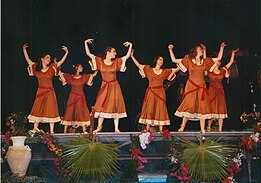
Israeli music |
|---|
| Religious |
| Secular |
| Israel |
| Dance |
| Music for holidays |
Jewish dance is dance associated with Jews and Judaism. Dance has long been used by Jews as a medium for the expression of joy and other communal emotions. Dancing is a favorite pastime and plays a role in religious observance. [1]
Contents
- Jewish vernacular dance
- Hasidic dance
- Horah
- Tza'ad Temani
- Jews in concert dance in the world
- Ballet
- Modern dance in Israel
- Modern dance in the United States
- See also
- References
- Further reading
- External links
Dances associated with Ashkenazi and Sephardi traditions, especially Jewish wedding dances, are an integral part of Jewish life around the world. Folk dances associated with Zionism and the formation of the State of Israel became popular in the 1950s. [2]
| Part of a series on |
| Jewish culture |
|---|
 |



